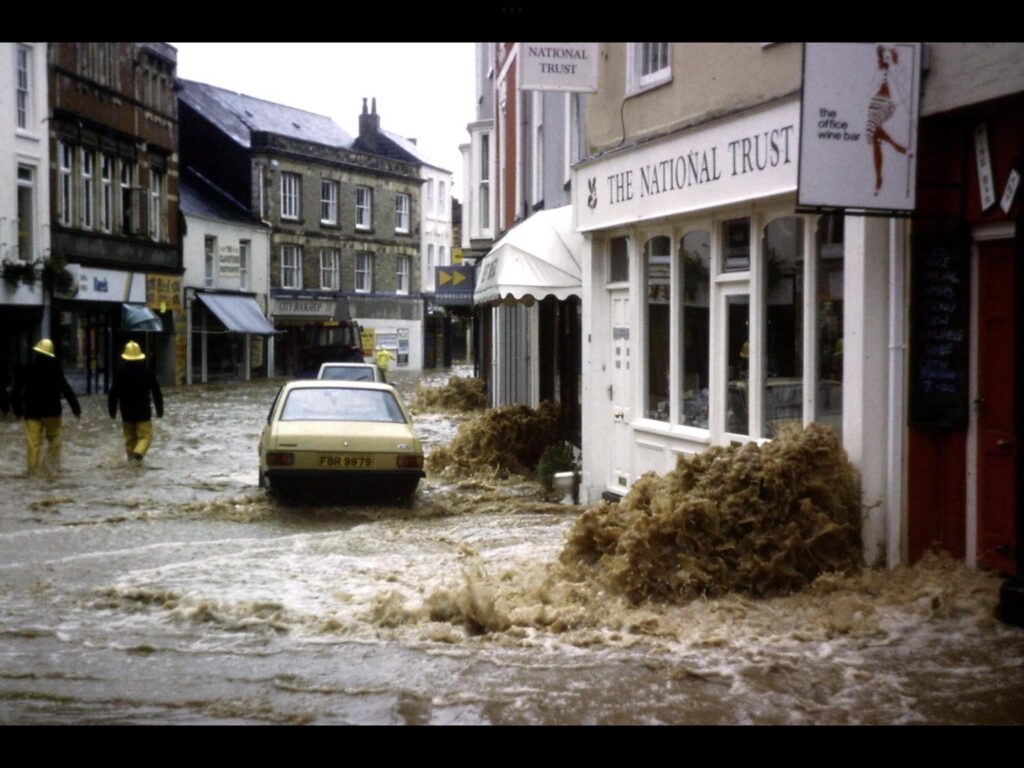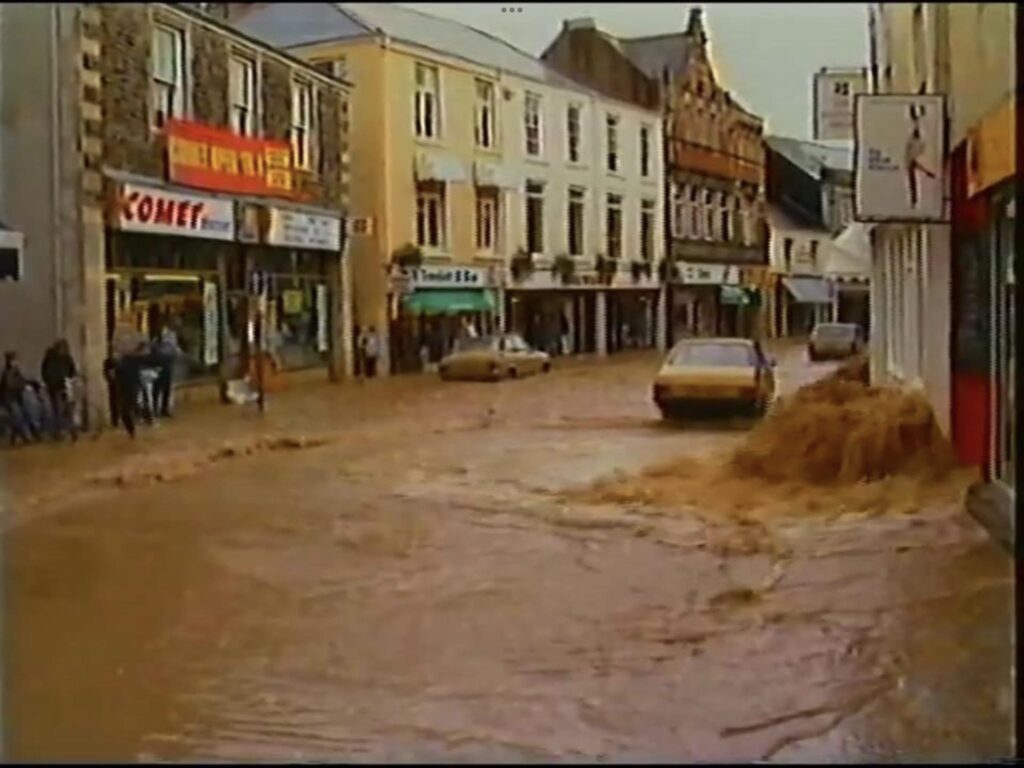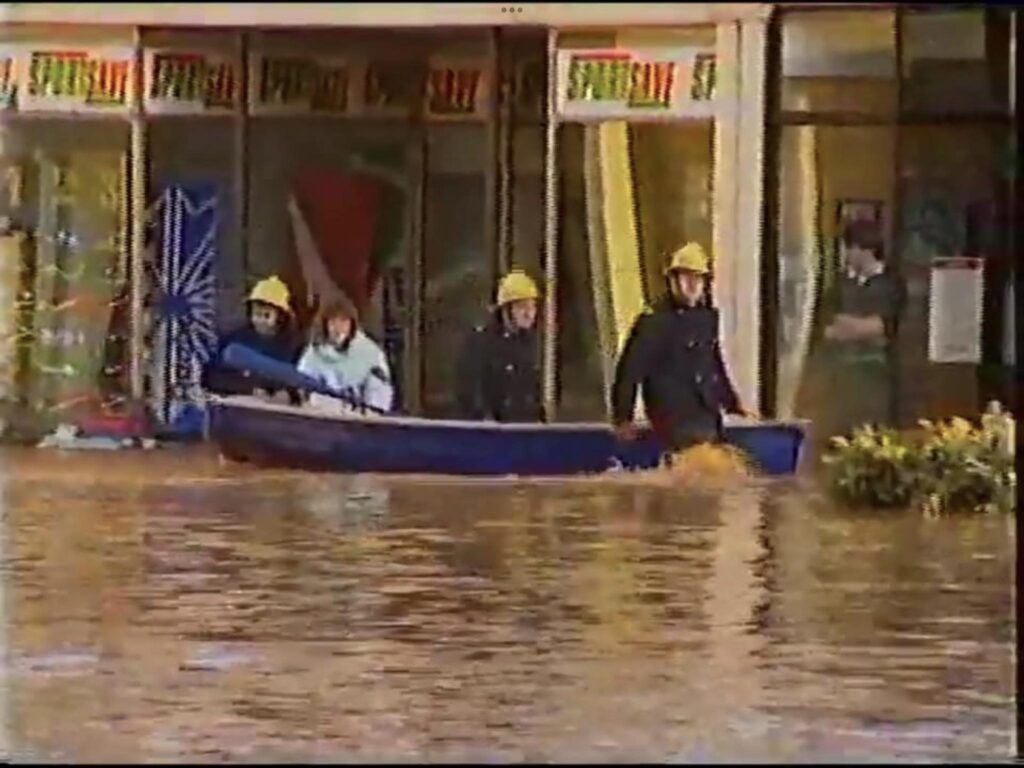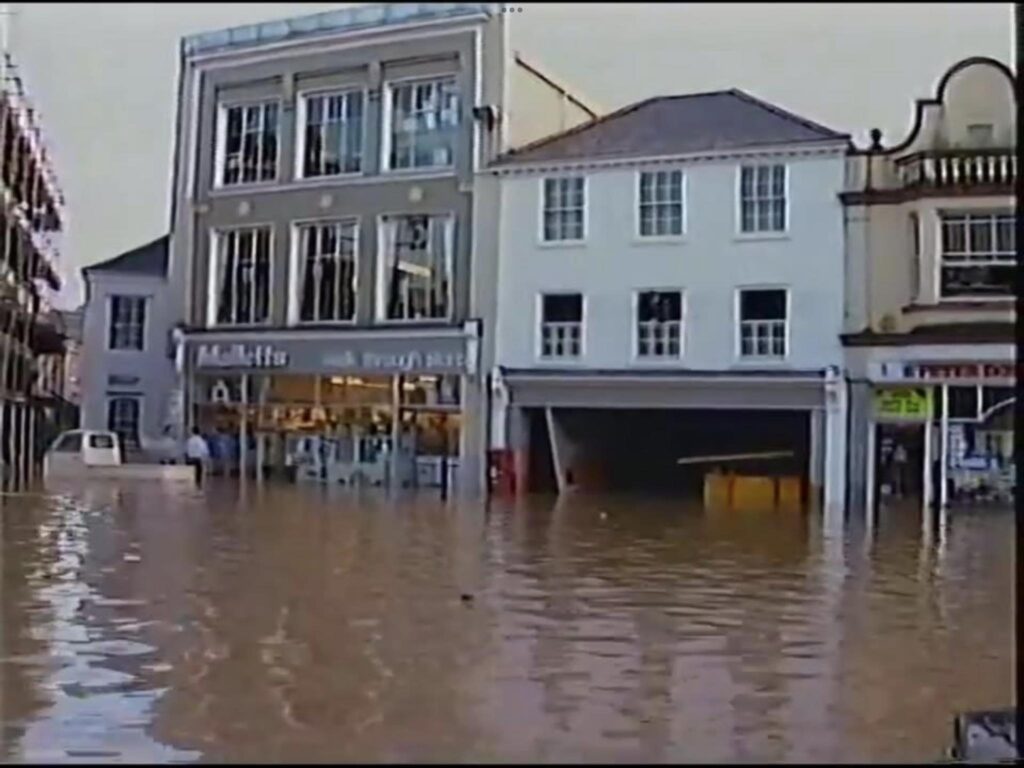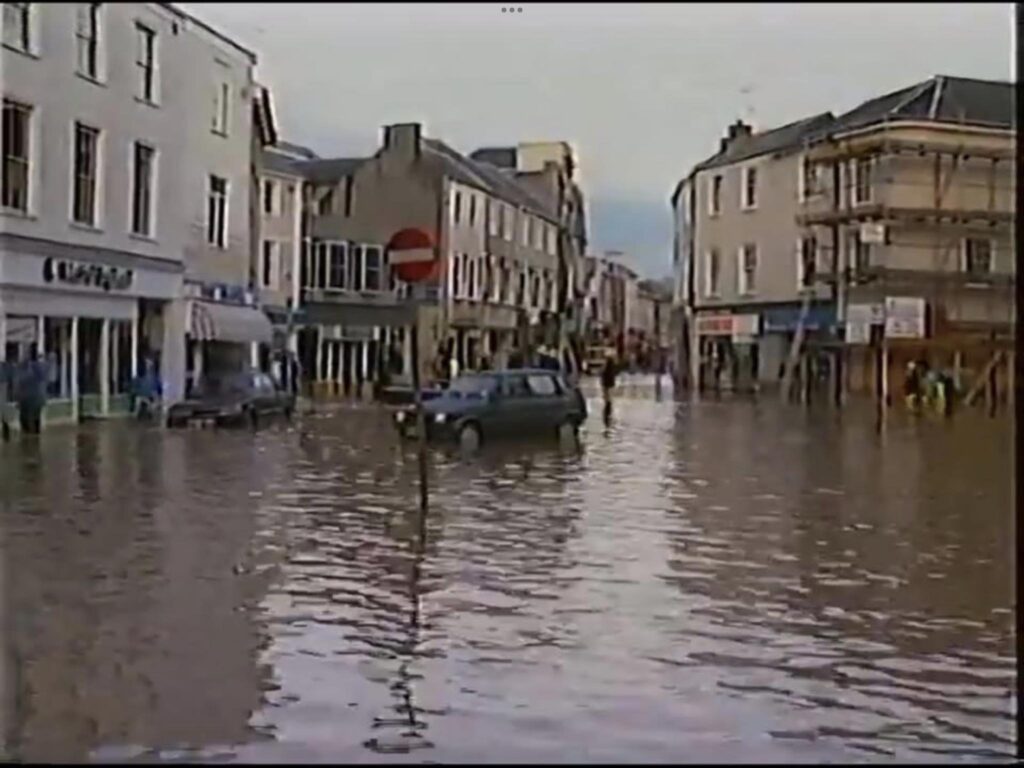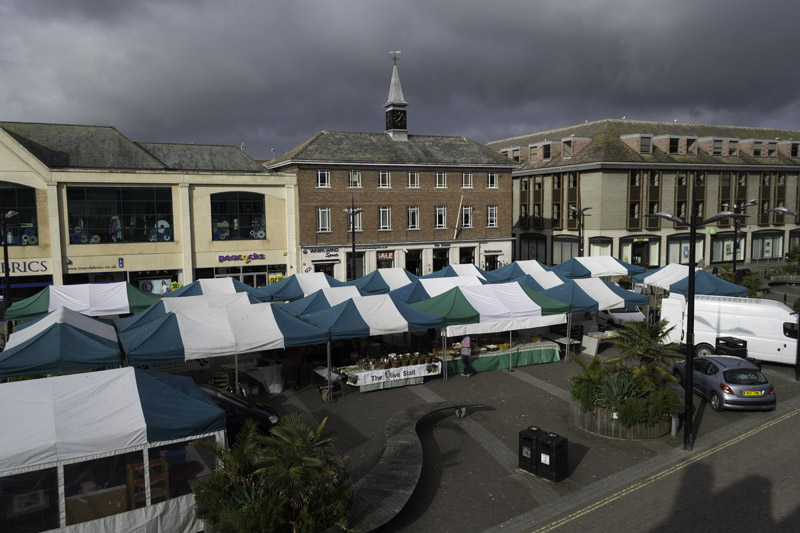1988 Floods-Recollections & Reflections
Luci Isaacson BEM**
Flooding in Truro has been a recurrent event, shaping the lives and stories of many. One of the most memorable floods in Truro’s history occurred in 1988, and it’s a time that remains vivid in the memories of those who lived through it. The city was hit by devastating floods twice in the same year, in January and again in October. The Truro flood of 1988 wasn’t just an environmental catastrophe; it became a moment that brought the community together in ways that are still remembered with both nostalgia and resilience.
I, too, have my own story from the 1988 floods. Like many, I joined in the effort to help where I could. I vividly recall helping to bale out water from Petite Pantry, a small shop located at the corner of Victoria Square. While I and others worked to salvage what we could, firefighters were busy rescuing people trapped in shops. In fact, there was an incident where the fire brigade had to row across the flooded square in rubber dinghies to rescue three women who were stuck on the first floor of Fox’s travel agency.
The store owned by Robert Mallett, a central figure during the floods, was among the hardest hit. His store was submerged under four feet of water, flooding the ground floor and filling the lift shaft. Despite the devastation, Robert remained positive. In fact, his attitude became symbolic of the wider community’s response. Everyone was upbeat, helping each other in the face of adversity. Robert lent the fire brigade rubber dinghies, demonstrating not only his generosity but also how the entire town pulled together to overcome the crisis.
“All my staff worked without question,” Robert later reflected. Despite the devastation, they were determined to reopen the store as soon as possible. “By 8:00 p.m., we stopped and went to get fish and chips from Sole Plaice. Everyone was amazing, and we all worked together.” This spirit of community cooperation was one of the silver linings of the flood, a memory I carry with me to this day.
The Long-term Solutions to Truro’s Flooding Problems
While the floods of 1988 brought people together, they also highlighted the need for long-term solutions to protect the town from future disasters. Robert Mallett, at the time the Mayor’s consort, played a significant role in the aftermath. Along with the lady mayor, he established a Flood Alleviation Committee that worked closely with South West Water, the local council, and other agencies. As a result of their combined efforts, two important flood prevention measures were implemented: the construction of storage dams on the rivers Kenwyn and Allen and the installation of a tidal gate at Newham.
These measures have played a crucial role in mitigating the risk of flooding in Truro, but they did not eliminate the problem entirely. Flooding is a complex issue, exacerbated by environmental changes that extend beyond the control of local infrastructure. Reflecting on the events of 1988, I hadn’t realised how deeply these experiences would shape my understanding of environmental challenges and my subsequent work in this area.
A Broader Perspective: Environmental Awareness and Flooding
In 1995, I moved to Greece, initially planning to stay for a few months, but I ended up living there for two years. During this time, I taught English, and as part of the curriculum, I helped students practice their pronunciation through discussions on various topics, including environmental issues. Over the course of three rounds of exams, I noticed a significant increase in environment-based topics, from 18% to 38%. This rise in environmental awareness made me realise that I needed to gather more comprehensive information on the subject.
I sought out Greenpeace Greece for relevant materials, a decision that marked a turning point in my life. On the day I visited their office, Athens was sweltering under an intense heatwave, and a rubbish strike had left the streets piled high with black sacks of materials. The heat was so extreme that the materials caught fire, sending thick, black smoke through the streets. As I fled the smoke, I stumbled upon the Greenpeace office, gasping for air. It was a surreal moment, but one that further fuelled my passion for environmental activism.
Despite the language barrier, I was able to understand the core of Greenpeace’s message: many environmental problems, including flooding, had relatively simple solutions. The problem wasn’t that these solutions didn’t exist; it was that they were not widely implemented. For example, many bad things could be prevented by changing behaviours or being better prepared. These two concepts—stopping harmful practices and preparing for potential disasters—became the cornerstones of my environmental philosophy.
After two years in Greece, I moved to New Zealand, where I continued working on environmental projects. Once again, I found myself dealing with issues related to pollution and its impact on natural ecosystems. Whether it was dieldrin in the ground or dioxins in my cereals, the common theme was that human activities were causing widespread environmental damage, much of which could be prevented with better practices and awareness.
Back Home in Cornwall: The Fight for Flood Prevention
When I eventually returned to the UK, I took up a position with the Falmouth-based Rag & Bone Recycling company. My work there helped expand the doorstep recycling services that are now commonplace, and it reinforced my belief that individual actions could make a big difference in tackling environmental issues. Around this time, a sailing friend introduced me to Earth Systems Science, a field that examines the interactions between the Earth’s atmosphere, oceans, and land surfaces.
Although I wasn’t an academic, I found the subject fascinating, particularly as it related to the broader issue of climate change. The more I learned, the clearer it became that human activities, especially the burning of fossil fuels, were contributing to global warming. This, in turn, was increasing the likelihood of extreme weather events, including floods. For every degree of warming, the atmosphere can hold 7-14% more water vapour, which has to fall as precipitation at some point. This phenomenon, known as atmospheric rivers, can lead to sudden and intense rainfall, which in turn causes flooding.
The Future of Flooding: Preparing Truro for the Challenges Ahead
Given these facts, the question now is: Are we ready to accept that climate change is already affecting us and that more flooding is inevitable? For many, the answer is no. This isn’t surprising, as environmental education was pretty much zero when I was in school, and it’s only recently become a central focus in the curriculum. But for those of us who have experienced flooding firsthand, like the people of Truro in 1988, and had chance to study climate change, the need for preparedness is clear.
Truro is particularly vulnerable to flooding because it sits at the confluence of three rivers. As the climate continues to change, the likelihood of more frequent and severe floods increases. However, there is hope. There are steps we can take to make our homes, workplaces, and communities more resilient. One such initiative is our new Continuing Professional Development (CPD) qualification, designed to educate people about climate resilience. This two-day course, open to all, provides practical advice on how to prepare for and mitigate the effects of flooding. It also includes a flood plan template that individuals can use to protect their homes or businesses. The first 400 are funded, get in touch to sign up.
For those interested in learning more about climate resilience, there’s also the opportunity to join a “Shaping Climate Vision CIC Walk and Talk” in Truro. This guided walk starts from the Truro River and offers a chance to discuss flooding and other climate-related topics with experts. Participants are given resources to help them create their own flood plans and reduce their carbon footprints.
A Call to Action: Protecting Truro for Future Generations
The tide gate and two river dams were designed in the early 1990s to provide a high standard of flood protection considering river and tidal flood. They work alongside river walls, channels, bridges and culverts which are often in private ownership and management and have provided a good level of protection since they were constructed. Surface water and sewer flooding has been a problem in a number of locations and upgrades to the system have been implemented by South West Water following flooding at Victoria Square. The combined surface and foul sewerage in Truro interacts with river and tidal flood management so that when high river flow and tides occur, drainage systems cannot discharge freely. With increasing rainfall, river flow, and rising sea level our current management systems will be put under more pressure.
Howard Simpson, Environment Agency
To address these challenges, the EA is starting a Strategic Appraisal Study in 2024. This study will assess the future flood risks in Truro and propose new measures to ensure the town’s long-term resilience. While infrastructure improvements will play a key role, individual preparedness is equally important. For questions and comments, please get in touch with their enquiries team at: DCISEnquiries@environment-agency.gov.uk
Conclusion: Flooding is Everyone’s Problem
The history of flooding in Truro is not just a story of natural disasters; it’s a story of community resilience and adaptation. From the floods of 1988 to the present day, the people of Truro have faced the challenges of flooding with determination and solidarity. But as climate change accelerates, the risks are growing, and we must all do our part to protect the city we love.
Whether it’s by taking part in the CPD course, developing a flood plan, or simply being more aware of the environmental impact of our actions, each of us has a role to play in making Truro more resilient to future floods. The time to act is now..
**Luci is a director of Climate Vision which is based in Truro. in 2020 she was awarded the British Empire Medal for her services to “Flood Risk Management in Cornwall”. You can contact her at luci@climatevision.co.uk
Rob Mallett
Yes remember it all well there was a flood in both January and October and we had about 4ft of water through the front doors and right up through the ground floor into the lift shaft about 4ft depth. Phoned the fire brigade who came and pumped it out. Opposite was Fox’s travel agents there were 3 ladies trapped on the first floor the fire brigade borrowed a couple of rubber dinghy’s to row across the square to rescue them. At the time I was the Mayor’s consort and the lady mayor set up a flood alleviation committee south west water, and the council several other agencies and through this we got the 2 holding dams and the lock gates at Boscawen park. Everyone helped each other we got a lot of publicity through it turned bad news into good news and all the traders had a flood sale. All my staff worked on without question so we could get open the next day. About 8.00pm we stopped and got fish and chips from Sole Plaice, took a cheque up. No, pay me when your sorted. Everyone was amazing and worked together
A series of superb b/w photos kindly supplied by Jay Williams
Photographed by Ken Hambley of Truro (deceased).
Bert Biscoe
I first met Mrs Armorel Carlyon whilst a member of Citizens of Truro – a group formed to oppose Carrick District Council’s attempts to sell-off Truro City Hall in the early 1980s. My efforts to hire the hall for a gig, only to find that CDC’s warped approach to its management meant I would have to hire it for 24 hours, led me towards standing for election to Truro City Council.
I was also much exercised by proposals to put weirs into the Millpool, to partly infill it, and to remove historic sluice gates from the bridge. I learned that the River Allen is a sanctuary for European Eels, which was, by the late 80s an endangered species. I was elected n 1987. I am still wrestling with that issue as the Pydar Street development proposals suggest a suburbanization of the River Allen and further risk to the eels. In 1988 Mrs Carlyon became Mayor..
In the meantime, we had formed Cornish Alternatives to the Structure Plan (CASP) to campaign for reform of the structure planning process. We ended up in Examinations in Public in the basement of the Falmouth Hotel of which, at the time, Mrs C was a shareholder – afternoon tea was most graciously served! We had many adventures – a situation which has continued to this day!
Twice during her Mayoral year floods struck Truro. They were both deemed ‘One in 300year’ events which, coming within ten months of each other, seemed a trifle ironic!
Armorel rose to her occasion. She demanded the presence of what was then the National Rivers Authority (later the Environment Agency), and many be-suited gentlemen appeared. I remember shutting one slightly bemused-looking engineer in the Parks Manager’s office with Les Williams (Manager of the Sewage Farm), John Cockle (First Mate to the last cargo ship registered in Truro), and Arnold Hodge (Freeman, engineer and tenacious political townsman) – it is said that, after two hours the NRA engineer emerged looking pale and his hair was turning white!
Mrs Carlyon pushed for concrete proposals to defend Truro from future floods. She did not let go and proposals came forward. It was then a case of finding the money. She took herself to London and marched around offices – always polite and determined, she won lasting respect for her civic leadership. As a committed Methodist she held to a strong ser of principles., and these sustained her bravery, her directness and her constant charm – the money was quickly identified.
Two dams were built to stem the flow of the rivers Allen and Kenwyn when necessary – that is, when heavy and persistent rain coincides with spring tides. Lock gates are recently renewed which are designed to hold back the tide when conditions require. And, a siren was installed at St George’s Road.
Mrs Carlyon’s tenacious, energetic, friendly and determined leadership has brought lasting safety to Truro. We have seen nothing like 1988. She would quickly say that many people helped, and some took risks, and that we should never be complacent – Nature is a mysterious and surprising mistress of the planet – she can unleash immense forces as quickly as she can charm a heavy heart with a primrose – and she can nurture rare talents and characters like Armorel Carlyon to cut like a scythe through grey forests of bureaucracy to protect families, places and businesses – and to achieve sanctuaries of peace and quiet for threatened and nervous eels –
In certain quiet corners of government offices and parliamentary corridors they still speak her name with respect and admiration.
Further memories welcome – just comment below
A personal recollection by Peter Brinton
We moved into St. George’s Road sometime in the summer of 1987 from a small terrace house in Daniell Street in Truro. Our daughter was about eighteen months old at the time. It was a big change to move from a small, two-bedroom terrace house to a large four-storey property albeit in need of extensive renovation.
Work was started on renovating the basement as this would provide a workspace for a new business.
The chronology of events has blurred with the passage of time but I was working as a teacher in Newquay at the time and getting a phone call (landline then) for me to come straight home at the end of the day as the level of the River Kenwyn was rising and the may be flooding. I arrive home after a somewhat apprehensive drive from Newquay to find the river level rising but no actual flooding of the house.
When it started it happened very quickly. Water started coming out of the toilet downstairs and the small back garden began to flood. Water leaked through the wall that separated the garden from the river Kenwyn and within minutes after that the basement was flooded to about a metre in depth. In many respects we got off better than might have been imagined. The upper floors of the house were not directly affected (although a bit soggy from all the toing and froing) but we nevertheless accepted the offer from friends who lived in Highertown to spend a couple of nights there.
And eight months or so later it happened again!
But that is only half the story. What can I remember that was driven by emotion. Firstly the Local Education Authority did not pay me for the two days I had off to sort things out! That really hurt at the time.
Secondly, the intense anger at the attitude of South West Water and the Environment Agency towards the inhabitants of the houses that flooded.
Thirdly, being interviewed on my doorstep by Westward Television (or was it the BBC?) and them panning down to show my trousers rolled up to my knees and my bare feet.
Fourthly, The coming together of the affected houses and families to help and support each other. Closed friendships developed and remain.
Fifthly, it spurred me on to become closely involved in local politics (Truro City Council and Carrick DC) in which I remained for about fifteen years.
Last night I spoke to my daughter and asked her what she remembered. She has two memories as an eighteen-month-old from that day. Barbara Parson’s cat being floated out of her basement flat on a cushion. And Ann Talbot’s large bright yellow raincoat.
We renovated the basement again and put in flood protection measures. The night storage heaters were removed and the central heating extended into the basement. The washing machine was placed on a plinth and the floors tiled so they could be brushed out. Shelves were all at above flood height. If I was ever flooded again the first thing I would do is save paper. Photographs, diaries and letters can not be replaced. Stuff can.
Peter Brinton


